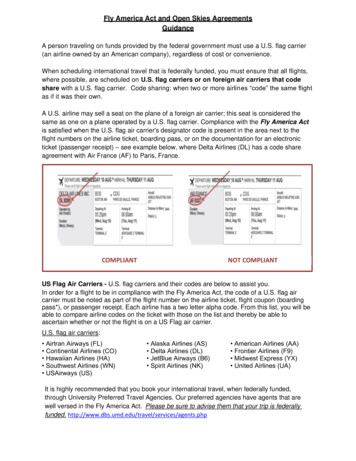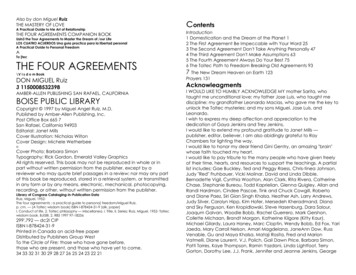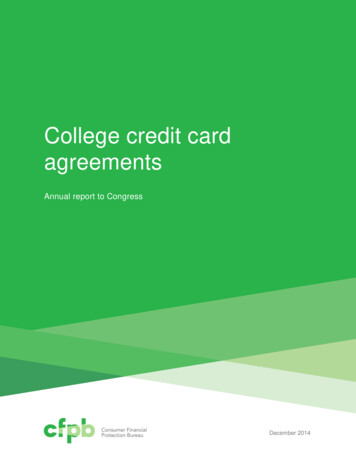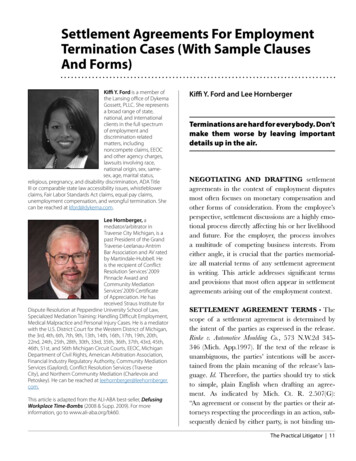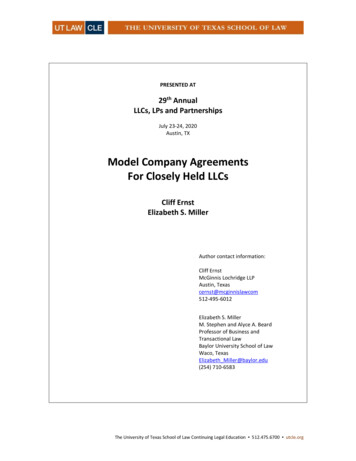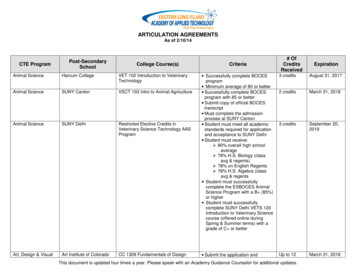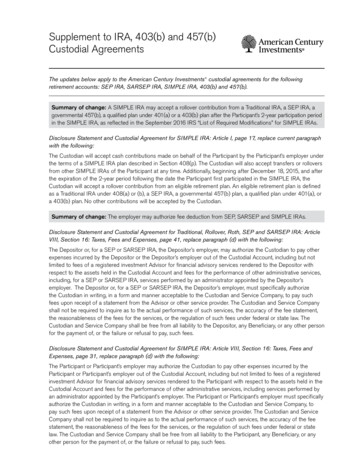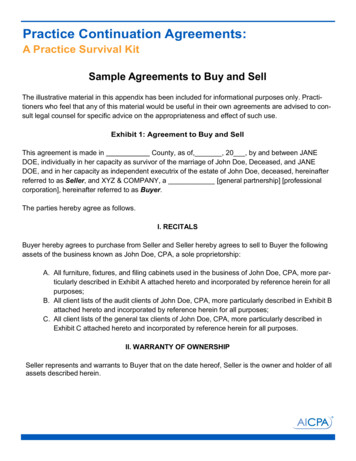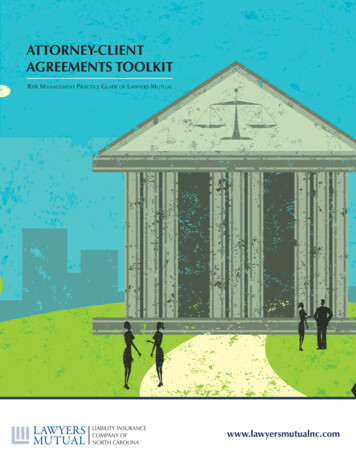
Transcription
Attorney-ClientAgreements ToolkitR isk M anagement P ractice G uide of L awyers M utualLAWYERSMUTUALLIABILITY INSURANCECOMPANY OFNORTH CAROLINAwww.lawyersmutualnc.com
LAWYERS MUTUAL LIABILITY INSURANCE COMPANY OF NORTH CAROLINA5020 Weston Parkway, Suite 200, Cary, North Carolina 27513Post Office Box 1929, Cary, North Carolina 27512-1929919.677.8900 800.662.8843 919.677.9641 FAX www.lawyersmutualnc.comDisclaimer: This document is written for general information only. It presents some considerations that might be helpful in your practice. Itis not intended as legal advice or opinion. It is not intended to establish a standard of care for the practice of law. There is no guarantee that followingthese guidelines will eliminate mistakes. Law offices have different needs and requirements. Individual cases demand individual treatment. Due diligence,reasonableness and discretion are always necessary. Sound risk management is encouraged in all aspects of practice.updated September 2017
Attorney-Client Agreements ToolkitR i s k M a n ag e m e n t P r ac t i c e G u i d eofLaw yers MutualTable of ContentsEngagement Letters2Non-engagement Letters10Dis-engagement Letters14Sample Letters Master Index18Sample LettersLETTER NOTIFYING CLIENT OF DESTRUCTION OF FILE . 19Engagement LettersPre-Engagement.20Simple . 21Hourly Fee .23Contingency Fee .27Alternate Clauses - Fees Paid in Advance: Advanced Payment,General Retainer, Flat Fee and Minimum Fee (2008 FEO 10).30Alternate Clauses - Third Party Payor of Fees and Expenses.32Joint Representation .33Local Counsel .37Limited Scope Retainer Agreement .39Consulting .42Virtual Law Office .44Practice Area Engagement LettersCorporate .49Alternate Clauses - Corporate.52Estate Planning .55Alternate Clauses - Estate Administration .57Family Law With Non-Litigating Client .59Family Law With Litigating Client .62Litigation .66Alternate Clauses - Litigation .68Medical Malpractice Fee Agreement .70Residential Real Estate Transaction - Full Title Search .72Residential Real Estate Transaction - Limited Title Search .75Non-Engagement LettersSimple Confirmation .78Confirmation of Non-Engagement .79Alternate Confirmation of Non-Engagement .80Awaiting Funds. 81Awaiting Further Instructions.82Conflict of Interest .83Declining Representation Following Review .84Declining Representation Following Research .85Failure to Keep Initial Appointment .86Agreement with Non-Represented .87Dis-engagement LettersClosing Letter .88Unpaid Fees .89Divergence of Interest .90Notification of a Malpractice Claim. 91Declining Further Representation.92–1–
attorney-client agreements toolkitengagement lettersThe Value of Engagement LettersA study completed by the American Bar Association Standing Committee on Lawyers Professional Liability reportedthat 17% of all malpractice claims are the result of a poor attorney-client relationship.1 Approximately 75% of allgrievances filed against lawyers are the result of poor communication. A well-drafted engagement letter is thefirst step in establishing a professional relationship with the client and is an effective way of meeting the duty tocommunicate with clients. Many potential claims and/or grievances can be avoided with the adoption of a firmwide policy to use an engagement letter for each new representation.Whenever a new matter is opened, an engagement letter should be drafted to avoid misunderstandings, to buildthe attorney-client relationship, and to establish evidence of both the scope of the engagement and the fees to becharged for the firm’s services.Rule 1.2(a) of the North Carolina Rules of Professional Conduct requires an attorney to abide by a client’s decisionsregarding the objectives of representation. Rule 1.4(a) mandates that all matters be continuously explained to thefull extent necessary to allow the client to adequately determine the course of representation. Rule 1.2(c), however,permits the lawyer to limit the scope of the representation to the duties that he or she agrees to undertake.2It is with these rules in mind that the engagement letter should be drafted. The primary purpose of the writtenengagement letter is to prevent misunderstandings regarding the responsibilities of each party to the attorneyclient agreement. Most importantly, documentation provides written evidence confirming the existence of an12The Lawyers Desk Guide to Preventing Legal Malpractice, ABA Standing Committee on Lawyers Professional Liability, 1999.See, e.g., Kansas Public Employees Retirement System v. Rock, 273 Kan. 481, 44 P.3d 407 (2002) (the lawyer is not a trustee of the client’s interest with a responsibility to flushout all possible problems, but his or her duty is instead defined by the services agreed upon in the engagement letter).–2–
Risk Management Practice Guide of Lawyers MutualCASESTUDYScope of EngagementA “pro-se” litigant hired an attorney to make a limited appearance for the purpose of negotiating asettlement and to file limited responsive pleadings. This limited scope was repeatedly communicated,but never reduced to writing. When opposing counsel prevented settlement and the attorney did notshow up for trial, a malpractice suit for approximately 9,500 was filed to recover judgment and thefees for appeal. An engagement letter would have saved the attorney the cost of litigating the matterand may even have helped the client better understand exactly what the lawyer’s responsibilities were.attorney-client relationship, who the parties to thatrelationship are, and exactly what each has agreedto do.3 The engagement letter establishes theresponsibilities that the firm will undertake, outlineslimitations on the services to be performed andprovides protection from later claims that the attorneyor firm failed to perform a designated service.4 Itprovides an estimation of the fees to be incurred andindicates how they will be calculated.5Finally, the engagement letter can contribute to conflictprevention simply by serving as a management toolin the firm. It can be used to set a written standard ofpractice and facilitate clear identification of the clientduring the preliminary stages, which allows the firm toproperly determine whether conflict of interest issueshave been resolved.Communication is KeyEverything that is contained in the engagementletter should first be discussed with the client. Theengagement letter then serves as a written recorddocumenting the scope of the representation and theexpectations and responsibilities of both the attorneyand the client.6During the consultation, stress the need for regularcommunication and the importance of the clientproviding information that is both complete andaccurate to the best of his or her knowledge. Notethat the client is responsible for notifying the firm ofany changes to personal information or residence,or of any extended periods of time when the clientwill be unavailable. Specifically outline any clientresponsibilities or tasks that need to be fulfilled,decisions that need to be made, or documents thatneed to be produced. It is wise to also provide achecklist and deadline for the completion of any of theaforementioned tasks.Reiterate that the firm has obligations throughout theprocess. Emphasize that the matter will be given dueattention and that services will be provided timely anddiligently. Offer reassurance that the client will beinformed as to the status of the case and that he orshe will be promptly notified in the event of any majordevelopments. Alert the client, however, that there arecertain areas when his or her consent will be requiredto proceed, such as when settlement offers are made.Discuss with the client the rules regardingconfidentiality and inform them if any exceptions to therule may be implicated. Stress the need for protection3456See, e.g., Varner v. Eves, 164 Or. App. 66, 990 P.2d 357 (1999), review denied 329 Or. 650, 994 P.2d 133 (2000)(the fee agreement is the final expression of contractual duties and oral evidence of contrary arrangement made prior to its signing should therefore not be admitted).See, e.g., Hummer v. Pulley, Watson, King & Lischer, P.A., 140 N.C. App. 270, 536 S.E.2d 349 (2000), on subsequent appeal 157 N.C. App 60, 577 S.E.2d (2003), review denied by357 N.C.459, 585 S.E.2d 758 (2003) (there is no valid claim of malpractice for acts outside the scope of engagement as delineated within a signed fee agreement).See, e.g., Foodtown, Inc. of Jacksonville v. Argonaut Insurance Company, 102 F.3d 483 11th Cir. (1996), reh’g denied (11th Cir. 1997) (an oral contingent fee agreement would notbe enforced when a written agreement provided a clear, enforceable standard).See, e.g., Fitzgerald v. Linnus, 336 N.J. Super. 458, 765 A.2d 251 (2001) (the attorney is not liable for failure to provide tax advice on the planning of an estate when theengagement letter delineates the scope as providing assistance with executrix duties for the decedent’s estate).–3–
attorney-client agreements toolkitof confidentiality and the inherent risks of cell-phones, emails or facsimiles.Inform the client that communication will only occur through authorizedchannels. Some firms require a separately signed authorization to useparticular mediums, which would include the client’s acceptance of therisks of unnecessary disclosure. Provide the client with a copy of the firm’spolicy on the standard time period for returned calls, and discuss whatshould be done in the event that the client’s call or email has not beenreturned.CASE STUDYSet Timelines andProvide UpdatesAn individual hired a lawyer forrepresentation in both a worker’scompensation claim and in a thirdparty tort claim arising out of theThe Emergency Engagementsame incident. While working onA potential client will occasionally wait until the last minute to seek counsel,leaving insufficient time for the firm to conduct the standard client intakeprocedures or to properly draft an engagement letter. To avoid missing thestatute of limitation or turning the client away, a limited engagement lettermay be used. The function of this document is to accept the engagement,but only for the express purpose of completing the time sensitive duties. Ifthe firm is to undertake any further representation, include a statement ofthe fees and instructions for the client to return on the following businessday to review and sign a standard engagement form and to partake in anyof the firm’s other standard client intake procedures.The limited engagement letter should be countersigned and returned to thefirm before any work is done on the client’s behalf. If necessary, this can beaccomplished via fax or other electronic mediums.the workers’ compensation claim,the attorney became distractedfrom the tort claim and missed thestatute of limitation. He suddenlyfound himself responsible forover 75,000 in damages. Thiscommon scenario could have beenprevented had the attorney set atimeline for the client during theengagement process or if updateswere provided in a reasonabletimeframe.Drafting the Engagement LetterAny claim for malpracticeThe introduction should clearly identify the client.Using proper legal names, document those that are represented. If thereare others who are reasonably related to the transaction, but whoseinterests the firm will not handle, expressly indicate them as well. Ifrepresenting a corporate client, make it clear that it is the interest of thecorporation that will be represented, not the interests of the president, theboard of directors, trustees, or any specific employees. It should also benoted whether or not subsidiary or parent companies are included in therepresentation.Furthermore, should the situation call for it, recommend that non-clientsseek separate counsel to represent their individual interests.–4–should be immediatelyreported in writing tothe firm’s professionalliability carrier. A lawsuitwill automatically triggerthe firm’s deductible andnecessitate the retention ofdefense counsel.
Risk Management Practice Guide of Lawyers MutualCASE STUDYScope of EngagementBefore the closing of a businesstransaction, an attorney washired specifically to file a UCC-1financial statement and to attendthe closing as a formality. He wasnot asked to draft or review anyof the documents. An error in thefinancing statement compromisedthe security interest on theproperty. Though he did notdraft any of the documents, theattorney was blamed for failureOutline the work to be performed and provide an approximate timeline ofthe case. Alert the client to the fact that the legal process can sometimes bea lengthy one. Let him or her know that he or she will promptly be madeaware of any significant changes to the anticipated schedule, but thatpatience will be necessary while handling the matter. Though not required,some firms dedicate a section of the engagement letter, or provide aseparate document, describing the legal system for those unfamiliar with it.Finally, clients also like to know who will be working on the matter andwho they should contact with questions. Identify the primary attorney whowill be working on the case and, if applicable, another member of thefirm that he or she can speak with in the event that the primary lawyer isunavailable. Identify anyone else within or outside of the firm who arelikely to become involved with the case. This may include expert witnesses,outside consultants, paralegals or professional staff members at the firm.If this information is unavailable at the time of the engagement, include ageneral statement that these services will be engaged as necessary.to notice the error before filing.During the resulting malpracticesuit, the trial court held the lawyeraccountable for 1,400,000 indamages. The lawsuit may havebeen avoided if the engagementletter limited the scope of theengagement.Enter information aboutprospective clients intothe firm’s database sothat future conflicts canbe avoided.Limiting the Scope of EngagementIt is not enough to simply delineate what will be done, but it is also wiseto document any reasonably related matters that will not be handled. Forexample, if a personal injury client discusses a potential sexual harassmentclaim during the consultation, add a note to the engagement letterdocumenting that your representation will not include the discriminationclaim. Failure to do so could result in the former client filing a frivolousclaim alleging negligence for failure to pursue the discrimination claim in atimely manner.7The “unbundling” of legal services, also known as “limited representation”is an increasingly common form of practice. The term refers to anarrangement where the lawyer agrees to some, but not all, of the legalservices usually completed during a representation. For example, thelawyer may agree to help “ghostwrite” a complaint for a client to file prose. In another case, a lawyer may agree to handle a client’s divorce, butnot the equitable distribution issues. In these cases, it is essential that theattorney document the limited scope of the engagement with a well draftedagreement.8 The American Bar Association Litigation Section published a78Federal employment discrimination claims must be filed with the EEOC within 180 days of the alleged violation. See 42 U.S.C. § 2000e- 5(e)(1); 29 U.S.C. § 626(d); 42U.S.C. § 12117(a).See, e.g., Lerner v. Laufer, 359 N.J. Super. 201, 819 A.2d 471, cert. denied by 177 N.J. 223, 827 A.2d 290 (2003) (an attorney is not liable for malpractice for failure to conductdiscovery when a signed engagement letter expressly limited the scope of engagement to reviewing the terms of a property settlement document).–5–
attorney-client agreements toolkit“Handbook on Limited Scope Legal Assistance” that includes numerousexamples of limited scope engagement contracts. The handbook canbe downloaded at: /report.pdf.Joint RepresentationCASE STUDYBill Frequentlyto Avoid LitigationWhile stopped in her vehicle,If jointly representing clients, explain that it is not uncommon for parallelinterests to diverge during the representation. Include the circumstancesunder which the firm may or may not continue to represent some of theparties. This typically involves a discussion of how representation willbe impacted if one client leaves for reasons other than a conflict, therequirement of informed consent to continue representing some clients inthe face of a conflict, and/or a promise not to seek disqualification of theattorney by the departing client.If representing multiple clients, the possibility of aggregate settlementsshould also be discussed, as should the process that will be involved if oneis offered. Rule 1.8(g) forbids an attorney from participating in an aggregatesettlement without obtaining the informed consent of all clients in a signedwritten agreement. Informed consent requires that all claims be discussedwith each person involved, including the nature of the claim and any pleainvolved. Furthermore, an offer cannot be acce
seek separate counsel to represent their individual interests. Any claim for malpractice should be immediately reported in writing to the firm’s professional liability carrier. A lawsuit will automatically trigger the firm’s deductible and necessitate



